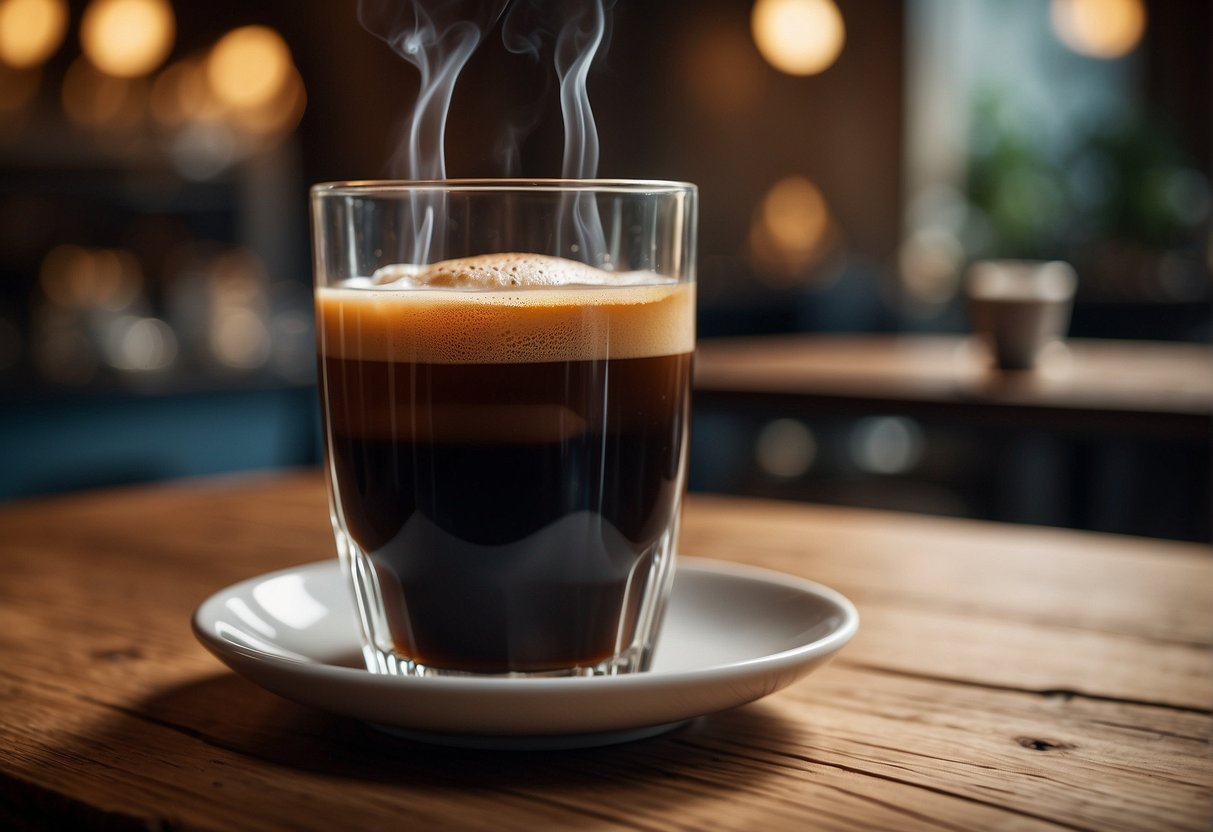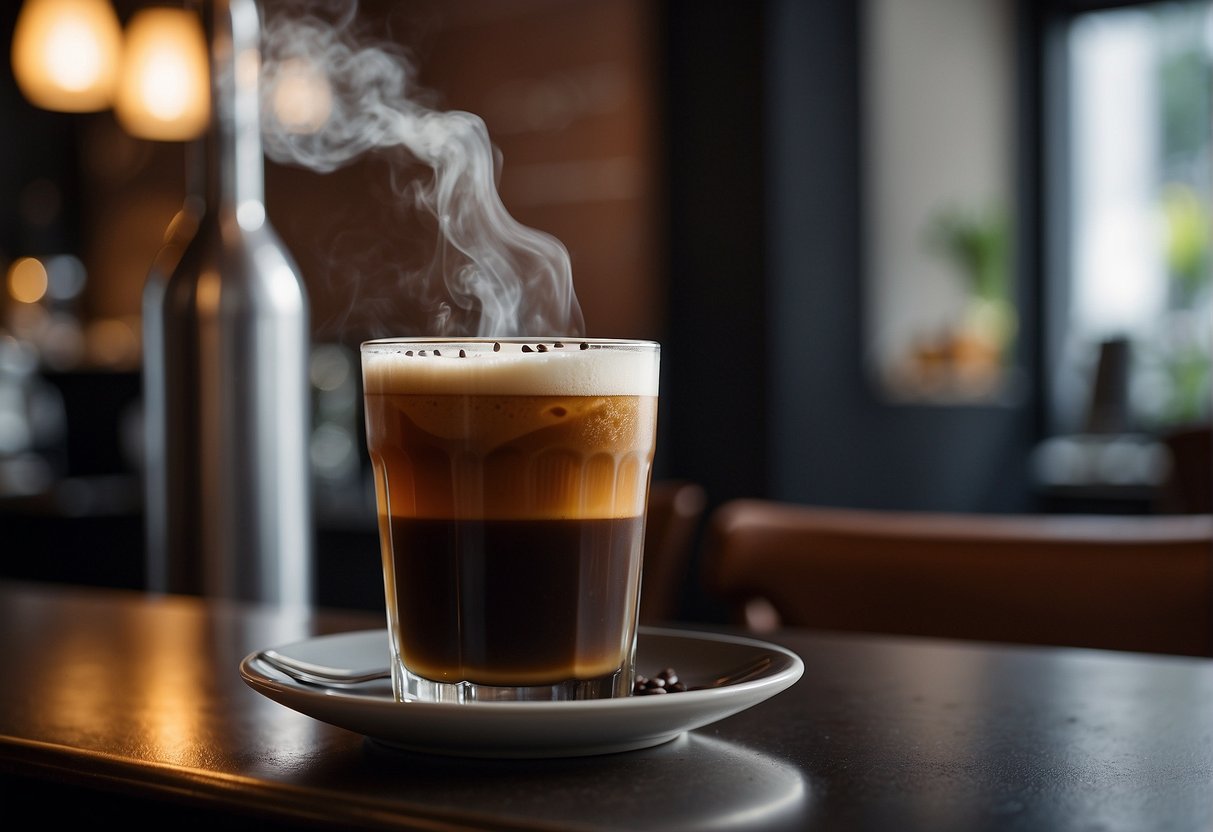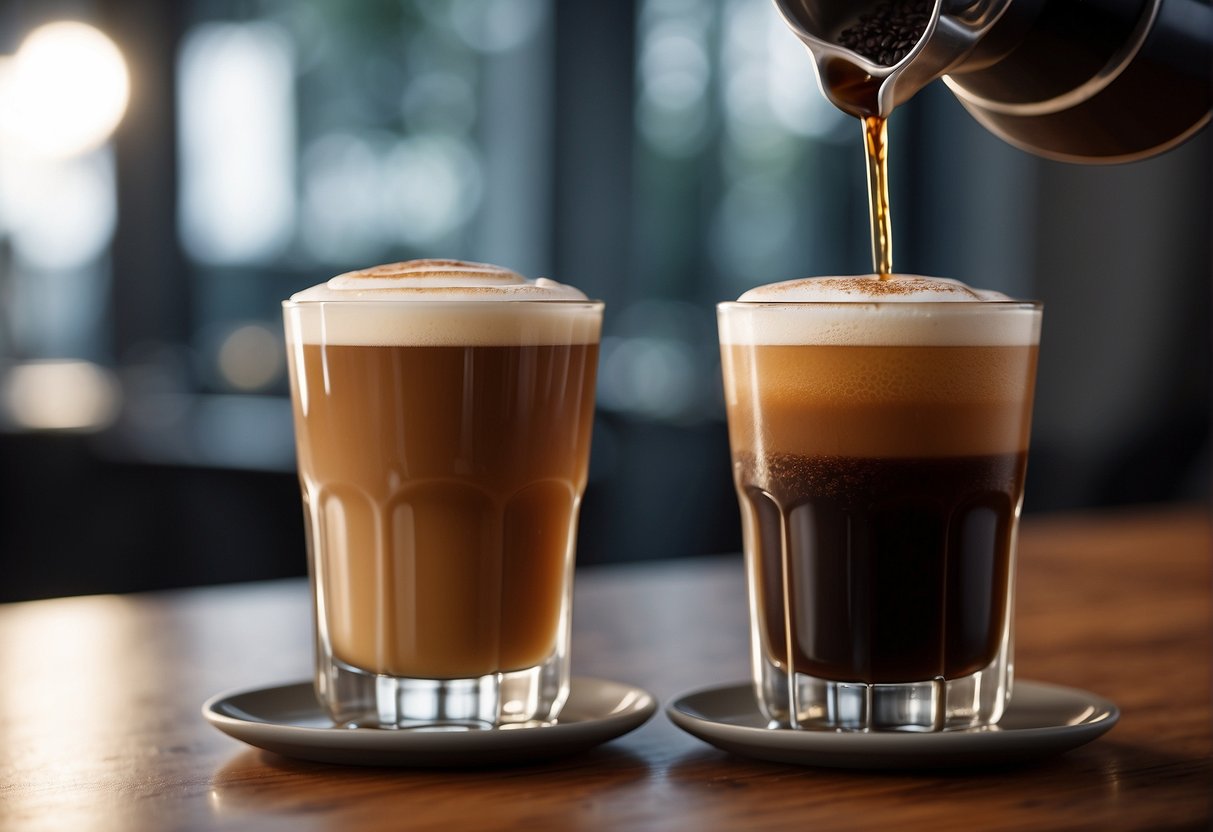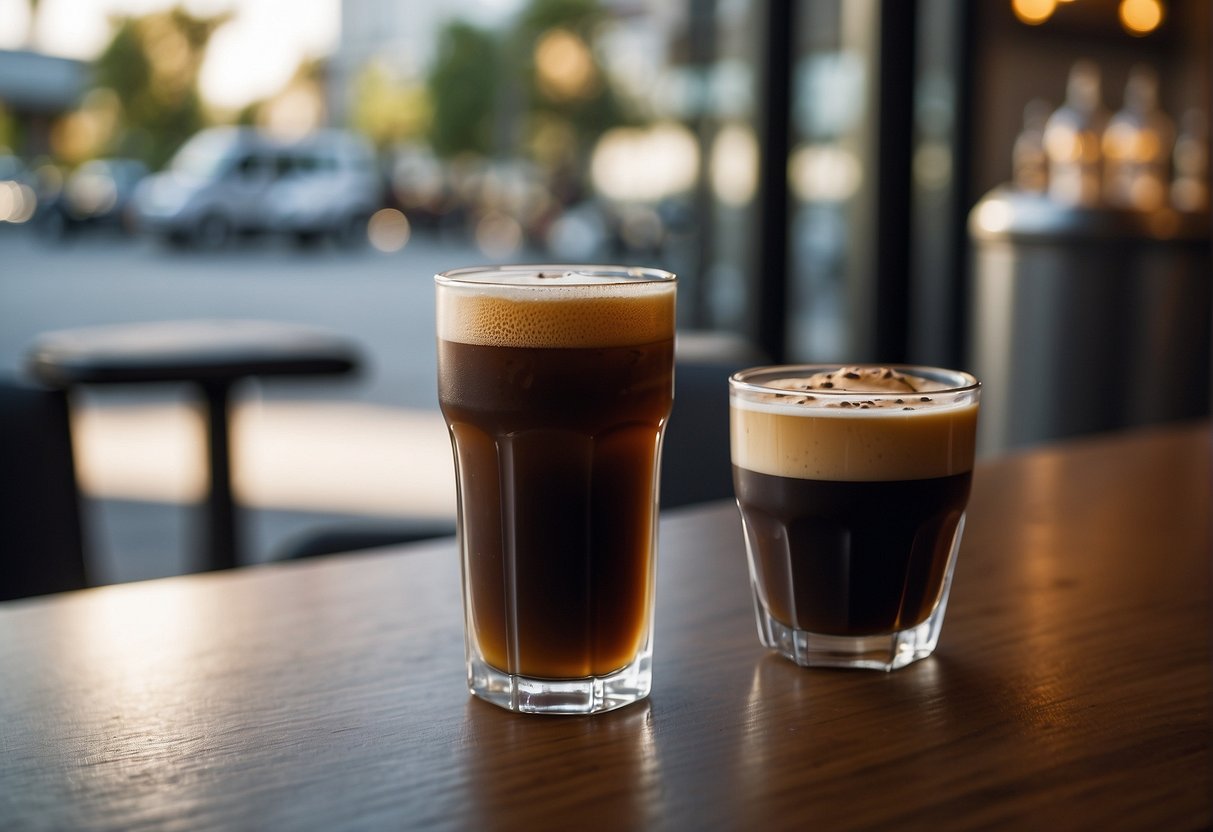Nitro cold brew and espresso are two popular coffee choices with distinct characteristics and appeal to different preferences. I understand the texture, process, and flavor profile deeply, having explored the world of coffee brewing extensively. Nitro cold brew, known for its smooth texture reminiscent of draft beer, is created by infusing cold brew coffee with nitrogen gas, which enhances its creamy body and enriches its taste. This process takes up to 24 hours, resulting in a refreshing and visually striking cup of coffee with a cascading effect much like a stout beer.

On the other hand, espresso is characterized by its concentrated form, delivering a potent shot of coffee with a notable crema on top. The method of preparing espresso involves forcing hot water through finely-ground coffee beans using high pressure, usually around 9 bar, which extracts rich flavors and aromas within a short span, typically 25 to 30 seconds. While both beverages are rooted in coffee, the differences in their brewing techniques, flavor profiles, and caffeine content offer unique experiences for coffee enthusiasts.
Key Takeaways
- Nitro cold brew is infused with nitrogen and has a smooth texture.
- Espresso is concentrated, with a quick extraction process.
- Both coffee styles differ in brewing technique, flavor, and caffeine content.
Understanding Coffee Basics
In exploring the essentials of coffee, I’ll examine the core brewing techniques and the influence of varying factors on caffeine content.
The Brewing Process Fundamentals
The foundation of a great cup of coffee lies in its brewing process, which is determined by several key factors. The choice of coffee beans significantly impacts the flavor profile and aroma of the beverage. Each bean carries distinct aromatic compounds and flavor compounds that develop through the roasting process. Grind size also plays a pivotal role; a finer grind is ideal for espresso, creating a concentrated coffee with a rich flavor, while a coarser grind suits cold brew, allowing for a slower extraction and reduced acidity.
The coffee-to-water ratio is another critical aspect. Espresso utilizes a high ratio for intensity, whereas cold brew uses more water for a milder, less acidic taste. Temperature influences the extraction of acidic, aromatic, and flavor compounds. Espresso requires hot water, extracting a full range of compounds quickly, resulting in a complex and bold taste. Conversely, nitro cold brew is made at low temperatures, imparting a smoother and sweeter flavor as fewer acidic compounds are extracted.
Caffeine Content in Coffee
The caffeine content in coffee can vary widely depending on the brewing method and the coffee-to-water ratio. Typically, a standard 1-ounce shot of espresso contains approximately 68mg of caffeine, which is highly concentrated. In contrast, an 8-ounce serving of cold brew may contain about 250mg of caffeine, as explained by YourDreamCoffee, due to prolonged contact between water and coffee grounds, allowing more caffeine extraction. Consequently, while espresso is more potent, cold brew can actually deliver more caffeine in larger servings. It’s interesting to note that the brewing time and temperature not only shape the flavor and acidity of the coffee but also influence the caffeine level extracted from the blends.
Nitro Cold Brew: An Overview

Nitro Cold Brew captivates coffee enthusiasts with its distinctive smooth texture and visually appealing creamy, foamy head. As a cold coffee option rapidly gaining popularity, it merges traditional cold brew techniques with a unique nitrogen infusion.
Characteristics of Nitro Cold Brew
The essence of Nitro Cold Brew lies in its signature texture and appearance. It’s defined by a smooth, creamy body that closely mimics the mouthfeel of a draft beer. I find that its foamy head, much like what you’d see atop a freshly poured pint, brings an aesthetic allure that’s as much a tactile pleasure as it is a visual treat. The addition of nitrogen gas not only contributes to this rich creaminess but also imparts a natural sweetness, which often means I can enjoy the beverage without adding extra sugar or sweeteners.
- Texture and Taste: Creamy, Smooth, Natural Sweetness
- Appearance: Foamy Head, Similar to Draft Beer
The Making of Nitro Cold Brew
To create Nitro Cold Brew, I start with cold brew, which is coffee steeped in cold water over an extended period, ranging from 12 to 24 hours. This brewing method alone makes for a coffee that’s less acidic and smoother than its hot-brewed counterparts. The next step, and what defines Nitro Cold Brew, is the infusion of nitrogen gas. This process usually occurs through a pressurized valve or tap system, akin to what’s used for kegged beers. The nitrogen infusion requires specific equipment like a keg and a nitrogen tank, which are common fixtures in coffee shops.
- Brewing Method: Slow-steeped in Cold Water
- Nitrogen Infusion: Using a Pressurized Valve or Keg System
Starbucks Cold Brew and other coffee establishments often serve Nitro Cold Brew straight from the tap, ensuring that rich cascade of coffee with every pour, maintaining that velvety consistency that I and so many others have come to savor.
Espresso and Its Distinct Features

As an avid coffee enthusiast, I’ve come to appreciate the unique characteristics that define espresso. It’s a concentrated coffee with a complexity of flavors and a rich legacy in coffee culture.
What Defines an Espresso
An espresso is a concentrated form of coffee prepared by forcing hot water through finely-ground coffee beans at high pressure. This quick extraction process, typically lasting 25 to 30 seconds, produces a small, potent shot of coffee with distinct layers, including the heart, body, and the beloved crema—a creamy, caramel-colored foam that floats on the surface, composed primarily of coffee oils and brewed coffee cells.
Table 1: Essential Espresso Characteristics
| Characteristic | Description |
|---|---|
| Volume | 25-30ml (typical shot size) |
| Brew Time | 25-30 seconds |
| Pressure | 9-10 atmospheres (at the brewing group) |
| Temperature | Hot water at 90-96°C |
| Flavor Profile | Bold, intense flavors with possible bitterness |
| Caffeine Levels | 68mg per 1-ounce shot |
| Crema | Golden creamy layer |
This intense extraction method gives espresso a strong coffee base that can be enjoyed on its own or used to craft a variety of espresso-based beverages.
Espresso-Based Coffee Variants
Some of the most popular espresso variants hinge on the addition of steamed milk and other components to soften and complement the boldness of the espresso. A cappuccino, for instance, balances equal parts espresso, steamed milk, and milk foam, offering a rich, yet balanced flavor and texture. A latte takes a more milk-forward approach, combining espresso with larger amounts of steamed milk and just a touch of foam.
List of Espresso-Based Drinks
- Cappuccino: Equal thirds of espresso, steamed milk, and foam.
- Latte: Primarily steamed milk with a shot of espresso, topped with a small amount of foam.
- Macchiato: An espresso “stained” with a dollop of milk or foam.
- Americano: Espresso with hot water added, diluting it to the strength akin to drip coffee but with a different flavor.
These derivatives of espresso cater to a range of preferences, allowing drinkers to enjoy the deep and concentrated flavor of espresso with various textures and taste nuances. The type of beans, their roast level, and the flavor notes also heavily influence each espresso shot and its subsequent beverages.
Comparative Analysis: Nitro Cold Brew vs Espresso

In this section, I’ll dissect the nuances between nitro cold brew and espresso, focusing on flavor, caffeine content, and their distinct serving methods.
Flavor and Texture
| Aspect | Nitro Cold Brew | Espresso |
|---|---|---|
| Flavor | Nitro cold brew is known for its smooth, rich taste with a slightly sweet profile due to nitrogen infusion. | Espresso boasts a highly concentrated flavor with apparent bitterness and acidity. |
| Texture | The nitrogen infusion provides a creamy, silky mouthfeel similar to that of draft beer. | Espresso has a distinctive syrupy body that can coat the palate. |
Caffeine Kick and Strength
| Aspect | Nitro Cold Brew | Espresso |
|---|---|---|
| Caffeine Strength | Generally offers a high caffeine content, though varying based on coffee origin and brewing time. | Known for a potent caffeine kick, espresso typically contains about 63 milligrams of caffeine per shot. |
| Perception of Strength | Its smooth texture may disguise its strong caffeine profile, presenting a deceivingly gentle kick. | The intense flavor and concentrated form often give the impression of a stronger caffeine hit, despite the actual content. |
Serving Styles and Consumption
| Aspect | Nitro Cold Brew | Espresso |
|---|---|---|
| Serving Style | Served cold, straight from the tap without additional flavors or additives. | Traditionally served in small shots, quickly consumed due to their intensity. |
| Consumption | Often enjoyed as a refreshing iced coffee alternative with lower acidity. | Sipping is customary due to the bold flavor and strength of the coffee beverage. |
In my analysis, these are the key differences and characteristics when comparing nitro cold brew to espresso. The contrast in flavor and texture is palpable, with nitro cold brew providing a creamier, smoother experience and espresso delivering a powerful, bold taste. Caffeine strength varies widely, but espresso is often perceived as stronger due to its concentrated nature and brewing technique which involves pressure. Serving styles also reflect these beverages’ identities, with nitro cold brew often enjoyed in a more relaxed setting, while espresso is typically quickly savored for a quick caffeine boost.
Frequently Asked Questions

Let’s explore some common inquiries regarding nitro cold brew and espresso, focusing on their caffeine content, flavor profiles, textural differences, nutritional variances, and brewing techniques, as well as the energy boost they provide.
What are the caffeine content differences between nitro cold brew and espresso?
The caffeine content in nitro cold brew typically exceeds that of espresso. Where a single shot of espresso contains about 75 mg of caffeine, nitro cold brew can offer a greater amount, due to both the brewing method and the volume served.
How does the taste of nitro cold brew compare to a traditional espresso?
Nitro cold brew offers a smoother and less acidic taste compared to espresso’s rich and concentrated flavor. Espresso is notable for its bold taste and quick extraction process which pulls out the coffee’s flavors swiftly and robustly.
Can you explain the texture differences between nitro cold brew and espresso beverages?
Certainly. Nitro cold brew has a texture that’s often likened to that of draft beer—it’s velvety due to the nitrogen infusion. In contrast, espresso has a syrupy consistency, which leaves a more pronounced coating on the palate.
What are the nutritional differences between nitro cold brew and espresso?
Nutritionally, both beverages are low in calories and contain no sugar unless added. However, due to its denser concentration, espresso may provide a slightly higher amount of certain compounds, such as magnesium and niacin, inherent to coffee beans.
How does the brewing process of nitro cold brew differ from that of espresso?
The brewing process of nitro cold brew involves steeping coffee grounds in cold water for extended periods, usually 12-24 hours, before infusing with nitrogen. Espresso, on the other hand, requires hot water passed through finely-ground coffee under high pressure for a quick extraction.
In terms of energy, which provides a stronger effect, nitro cold brew or espresso?
While both drinks are energizing, the effect can feel different due to caffeine content and rate of consumption. Nitro cold brew typically contains more caffeine compared to a shot of espresso, thus potentially providing a more sustained energy effect. However, the concentrated nature of espresso might lead to a quicker perceived boost.

